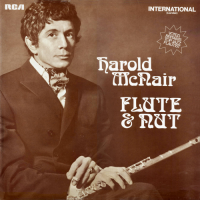
Harold McNair is barely known today. Yet he was one of the prettiest and most exciting modern flutists of the late 1960s and very early '70s. He was a beautiful saxophonist as well. McNair got off to a slow start in the jazz world and when he did, jazz was fading away for newcomers. Born in Jamaica, McNair spent the first 10 years of his musical career playing Caribbean music in the Bahamas. A self-taught musician, McNair soon found himself on a dreaded Calypso track despite his passion for jazz.
In 1960, Quincy Jones hired McNair for his touring “Birth of a Band" orchestra, and McNair left for Europe with the band. It's unclear how Jones came to hear him. McNair was a member of the Jones orchestra when it was recorded live in Lausanne, Switzerland, in June 1960.
By 1961, McNair was living full-time in London, and he recorded albums with British jazz drummer Tony Crombie and percussionist-vocalist Jack Costanzo. In late 1961, McNair led a group at Ronnie Scott's club in London, but as work dried up, he returned to the Bahamas to record. Back in London in 1965, McNair gigged and recorded Affectionate Fink, a leadership album backed by Alan Branscombe (p) David Izenzon (b) and Charles Moffett (d), who played with Ornette Coleman at the time.
McNair's next recording came in 1967, when he was taped live with Eddie “Lockjaw" Davis in Manchester (Oh Gee! Live in Manchester 1967), and the following year he recorded a leadership album, Harold McNair, that included a moderate instrumental hit called The Hipster. In '68 he moved on to orchestral recordings led by British bandleader Vic Lewis.
McNair was at his peak in 1970, when he recorded mostly on flute backed by an enormous swinging orchestra with strings arranged by John Cameron. The resulting RCA studio album was called Flute & Nut, and the recording finally established him as a powerhouse player Sadly, there are no details about the story behind the album or the personnel. The album's tracks are Umbrella Man, The Night Has a Thousand Eyes (killer arrangement and flute solo), You Are Too Beautiful, Barnes Bridge, Nomadic Joe, Herb Green, My Romance (on which McNair plays alto sax) and Burnt Amber.
The music is hypnotic. The arrangements are smart and driving, and McNair sails above the action, swooping in and out with strong, sensual lines. A number of the flute tracks feature McNair's humming-playing technique. No matter how many times I listen to the album, I never tire of hearing it.
After this album, McNair spent the balance of 1970 recording on Blossom Dearie's That's the Way I Want It to Be and John Cameron's Whole Lotta Love as well as recording an excellent leadership album called The Fence, with Steve Winwood on organ.
And that was it. Harold McNair died of lung cancer in March 1971. He was only 39.
JazzWax tracks: You'll find Harold McNair's Flute & Nut teamed with Harold McNair here. The album is also available for free listening at Spotify.
In 1960, Quincy Jones hired McNair for his touring “Birth of a Band" orchestra, and McNair left for Europe with the band. It's unclear how Jones came to hear him. McNair was a member of the Jones orchestra when it was recorded live in Lausanne, Switzerland, in June 1960.
By 1961, McNair was living full-time in London, and he recorded albums with British jazz drummer Tony Crombie and percussionist-vocalist Jack Costanzo. In late 1961, McNair led a group at Ronnie Scott's club in London, but as work dried up, he returned to the Bahamas to record. Back in London in 1965, McNair gigged and recorded Affectionate Fink, a leadership album backed by Alan Branscombe (p) David Izenzon (b) and Charles Moffett (d), who played with Ornette Coleman at the time.
McNair's next recording came in 1967, when he was taped live with Eddie “Lockjaw" Davis in Manchester (Oh Gee! Live in Manchester 1967), and the following year he recorded a leadership album, Harold McNair, that included a moderate instrumental hit called The Hipster. In '68 he moved on to orchestral recordings led by British bandleader Vic Lewis.
McNair was at his peak in 1970, when he recorded mostly on flute backed by an enormous swinging orchestra with strings arranged by John Cameron. The resulting RCA studio album was called Flute & Nut, and the recording finally established him as a powerhouse player Sadly, there are no details about the story behind the album or the personnel. The album's tracks are Umbrella Man, The Night Has a Thousand Eyes (killer arrangement and flute solo), You Are Too Beautiful, Barnes Bridge, Nomadic Joe, Herb Green, My Romance (on which McNair plays alto sax) and Burnt Amber.
The music is hypnotic. The arrangements are smart and driving, and McNair sails above the action, swooping in and out with strong, sensual lines. A number of the flute tracks feature McNair's humming-playing technique. No matter how many times I listen to the album, I never tire of hearing it.
After this album, McNair spent the balance of 1970 recording on Blossom Dearie's That's the Way I Want It to Be and John Cameron's Whole Lotta Love as well as recording an excellent leadership album called The Fence, with Steve Winwood on organ.
And that was it. Harold McNair died of lung cancer in March 1971. He was only 39.
JazzWax tracks: You'll find Harold McNair's Flute & Nut teamed with Harold McNair here. The album is also available for free listening at Spotify.
This story appears courtesy of JazzWax by Marc Myers.
Copyright © 2024. All rights reserved.


























